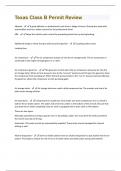Texas Class B Permit Review
Attitude - A good attitude is a professional truck driver's badge of honor. Sharing the roads with
automobiles must be a safety concern for the professional driver
ABS - Keeps the vehicle under control by preventing wheel lock up during braking.
Additional things to check during a walk-around inspection - Coupling system areas
Landing Gear
Air compressor - The air compressor pumps air into the air storage tanks. The air compressor is
connected to the engine through gears or a v-belt.
Air compressor governor - The governor control when the air compressor will pump air into the
air storage tanks. When air tank pressure rises to the "cut-out" level (around 125 psi), the governor stops
the compressor from pumping air. When the tank pressure falls to the "cut-in" pressure (around 100 psi),
the governor allows the compressor to start pumping again.
Air storage tanks - Air storage tanks are used to hold compressed air. The number and size of air
tanks varies among vehicles.
Air tank drains - Compressed air usually has some water and some compressor oil in it, which is
bad for the air brake system. The water and oil tend to collect in the bottom of the air tank. Be sure that
you drain the air tanks completely. Each air tank is equipped with a drain valve in the bottom.
There are two types:
Manually operated by turning a quarter turn or by pulling a cable. You must drain the tanks yourself at
the end of each day of driving.
Automatic--The water and oil are automatically expelled. These tanks may be equipped for manual
drilling as well.
Alcohol Evaporator - Some air brake systems have an alcohol evaporator to put alcohol into the air
system. This helps to reduce the risk of ice in air brake valves and other parts during cold weather.
,All trailers and converter dollies built on or after - March 1, 1998 are required to have ABS
All vehicles built since 1994 - Have automatic slack adjusters.
Approximately 5,500 people - Are killed each year on U.S. roadways and an estimated 448,000 are
injured in motor vehicle crashes involving distracted driving.
Research indicates that the burden of taking on a cell phone saps the brain of 39% of the energy it would
normally devote to safe driving.
.
100,000 - Police reported crashes a year are the result of drowsy driving.
Backing with a trailer - When backing a car, straight truck, or bus, you turn the top of the steering
wheel in the direction you want to go. When backing a trailer, you turn the steering wheel in the
opposite direction. Once the trailer starts to turn, you must turn the wheel the other way to follow the
trailer.
Look at your path.
Use mirrors on both sides.
Back slowly.
Correct drift immediately.
Pull Forward.
Basic method for shifting up - Release accelerator, push in clutch and shift to neutral at the same
time, release clutch, let engine and gears slow down to the rpm required for the next gear, push in clutch
and shift to the higher gear at the same time, release clutch and press accelerator at the same time.
Basic procedures for shifting down - Release accelerator, push in clutch, and shift to neutral at the
same time, release clutch, press accelerator, increase engine and gear speed to the rpm required in the
lower gear, push in clutch and shift to lower gear at the same time, release clutch and press accelerator
at the same time.
, Before driving a vehicle with a dual air system - Make sure the air compressor is at a minimum of
100 psi in both the primary and secondary systems.
The warning light and buzzer should come on before the air pressure drops below 60 psi in either
system.
Before entering a curve - Downshift to the right gear
Before starting down a hill - Downshift to a gear lower than the gear required to climb the same
hill.
Black ice - Black ice is a thin layer that is clear enough that you can see the road underneath it.
Brake drums must not have - Cracks longer than one half the width of the friction area.
Brake Drums, Shoes, and Linings - Brake drums are located on each end of the vehicle's axles. The
wheels are bolted to the drums. The braking mechanism is inside the drum. To stop, the brake shoes and
linings are pushed against the inside of the drum. This causes friction, which slow the vehicle.
Brakes A. - Trailers, semitrailers, and pole trailers with a gross weight of 4500 pounds or less are
exempt from brake requirements. Trailers, semitrailers, and pole trailers with a gross weight in excess of
4500 pounds and which do not exceed 15000 pounds and operated at speeds of 30 miles per hour or
less are not required to be equipped with brakes. Trailers, semitrailers, and pole trailers with a gross
weight in excess of 4500 pounds and which do not exceed 15,000 pounds and are operated at speeds in
excess of 30 miles per hour must have brakes acting on both wheels of the rear axle.
Brakes B. - Every motor vehicle, trailer, semitrailer, pole trailer, and combination of such vehicles
equipped with brakes shall have the braking system so arranged that one control device can be used to
operate all brakes. This does not prevent the use of additional control devices to operate brakes on the
towed vehicles. Surge or inertia brake systems may be used on trailers and semitrailers with a gross
weight of 15,000 pounds or less.
Brakes C. - Under all conditions, the combination of vehicles must be capable of complying with
the performance requirements. Generally, if the trailer and the combination is 3000 pounds or less, the
combination must be able to stop within 40 feet when traveling 20 miles per hour; if the trailer and the





